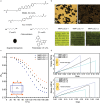Magneto-Photochemically Responsive Liquid Crystal Elastomer for Underwater Actuation
- PMID: 39788547
- PMCID: PMC11758782
- DOI: 10.1021/acsami.4c14704
Magneto-Photochemically Responsive Liquid Crystal Elastomer for Underwater Actuation
Abstract
The quest for small-scale, remotely controlled soft robots has led to the exploration of magnetic and optical fields for inducing shape morphing in soft materials. Magnetic stimulus excels when navigation in confined or optically opaque environments is required. Optical stimulus, in turn, boasts superior spatial precision and individual control over multiple objects. Herein, we bring these two methodologies together and present a monolithic liquid crystal elastomer (LCE) system that synergistically combines magnetic and photochemical actuation schemes. The resultant composite material showcases versatile possibilities for underwater actuation, and we demonstrate robotic functionalities where the optical and magnetic response can be leveraged in different tasks (object gripping and object translocation, respectively) or where light can be used as a control signal to tune the magnetically induced actuation. Combining these two remote actuation methods offers powerful, dual-mode control in wireless, small-scale robotics, especially in submersed environments due to their isothermal nature.
Keywords: azobenzene; liquid crystal elastomer; magnetoresponsive; shape morphing; soft actuator.
Conflict of interest statement
The authors declare no competing financial interest.
Figures





Similar articles
-
Liquid Crystal Elastomer-Based Magnetic Composite Films for Reconfigurable Shape-Morphing Soft Miniature Machines.Adv Mater. 2021 Feb;33(8):e2006191. doi: 10.1002/adma.202006191. Epub 2021 Jan 14. Adv Mater. 2021. PMID: 33448077 Free PMC article.
-
Azobenzene-Functionalized Semicrystalline Liquid Crystal Elastomer Springs for Underwater Soft Robotic Actuators.Small. 2025 Feb;21(8):e2406493. doi: 10.1002/smll.202406493. Epub 2024 Oct 21. Small. 2025. PMID: 39428897
-
Liquid Crystal Elastomer-Liquid Metal Composite: Ultrafast, Untethered, and Programmable Actuation by Induction Heating.Adv Mater. 2024 Aug;36(34):e2302765. doi: 10.1002/adma.202302765. Epub 2023 Oct 27. Adv Mater. 2024. PMID: 37656872
-
Structure-induced Intelligence of Liquid Crystal Elastomers.Chemistry. 2023 Jul 6;29(38):e202301027. doi: 10.1002/chem.202301027. Epub 2023 Jun 5. Chemistry. 2023. PMID: 37129950 Review.
-
Liquid Crystal Networks Meet Water: It's Complicated!Adv Mater. 2024 Mar;36(12):e2303740. doi: 10.1002/adma.202303740. Epub 2023 Sep 28. Adv Mater. 2024. PMID: 37392137 Review.
Cited by
-
Molecular Steganography Using Multistate Photoswitchable Hydrazones.J Am Chem Soc. 2025 Jun 11;147(23):19444-19449. doi: 10.1021/jacs.5c03668. Epub 2025 May 28. J Am Chem Soc. 2025. PMID: 40435281 Free PMC article.
References
-
- Zhao Y.; Hua M.; Yan Y.; Wu S.; Alsaid Y.; He X. Stimuli-responsive polymers for soft robotics. Ann. Rev. Control, Rob., Auton. Syst. 2022, 5 (1), 515–545. 10.1146/annurev-control-042920-014327. - DOI
-
- Ula S. W.; Traugutt N. A.; Volpe R. H.; Patel R. R.; Yu K.; Yakacki C. M. Liquid crystal elastomers: an introduction and review of emerging technologies. Liq. Cryst. Rev. 2018, 6 (1), 78–107. 10.1080/21680396.2018.1530155. - DOI
LinkOut - more resources
Full Text Sources

